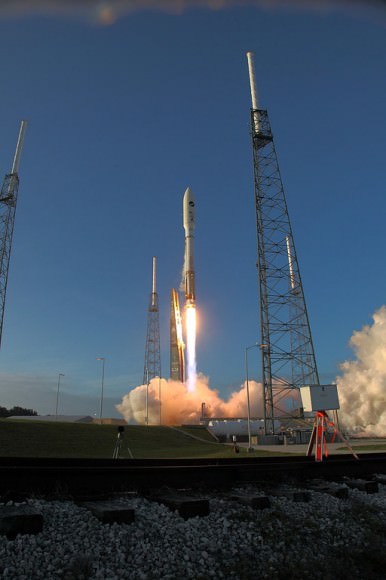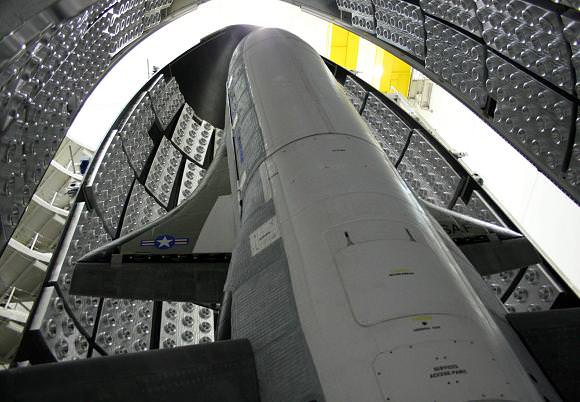Video provided courtesy of United Launch Alliance
The United States Air Force’s second flight of the X-37B – is headed into extra innings. Known as the Orbital Test Vehicle 2 (OTV-2) this robotic mini space shuttle launched from Cape Canaveral Air Force Station’s Space Launch Complex 41 (SLC-41) on Mar. 5, 2011. Although the U.S. Air Force has kept mum regarding details about the space plane’s mission – it has announced that the OTV-2 has exceeded its endurance limit of 270 days on orbit as of the end of November.
The OTV is launched atop a United Launch Alliance (ULA) Atlas V 501 rocket. The space plane is protected within a fairing until it reaches orbit. After separation, the diminutive shuttle begins its mission.
OTV mission USA-226, as it is officially known, is by all accounts going smoothly and the spacecraft is reported to be in good health. The U.S. Air Force has not announced when OTV-2 will be directed to land.
[/caption]
The fact that the space plane will continue to orbit beyond what its stated limits are highlights that the OTV has greater capabilities than what was officially announced. The first OTV flight launched in April of 2011 and landed 224 days later at Vandenberg Air Force Base in California. The U.S. Air Force is undoubtedly being more judicious with fuel stores on board the robotic spacecraft, allowing for a longer duration flight.
Much like NASA’s retired fleet of space shuttle orbiters, the OTV has a payload bay that allows for payloads and experiments to be conducted on-orbit. What payloads the U.S. Air Force has had on either mission – remains a secret.
Boeing has announced that the X-37B could be modified to conduct crewed missions to and from orbit. Tentatively named the X-37C, this spacecraft would be roughly twice the size of its unmanned cousin. If this variant goes into service it would be used to transport astronauts to and from the orbiting International Space Station (ISS).

The X-37B has become a bit controversial of late. Members of the Chinese press have stated that the space plane raises concerns of an arms race in space. Xinhua News Agency and China Daily have expressed concern that the OTVs could be used to deliver weapons to orbit. The Pentagon has flatly denied these allegations. The clandestine nature of these flights have led to a wide variety of theories as to what the OTVs have been used to ferry to orbit.


it looks a bit bigger than the x15, could it be converted to a crew ferry vehicle?
If anything, the X-37b is smaller than the X-15…
http://www.ipmsstockholm.org/magazine/2004/03/images/x15_01.jpg
http://luckybogey.files.wordpress.com/2009/09/h_x37_mojave_02.jpg
…which was not orbit-capable itself (though there was talk of upgrades and an ELV launch that might’ve made it marginally able to do one orbit).
One person just might fit into the X-37b’s payload bay, coffin style…and it would mean standing up during launch acceleration as well. No thanks.
The X-37C variant, proposed by Boeing to carry crew, would be about two times bigger than the actual X-37B. See: http://i.space.com/images/i/12563/original/x-37b-size-comparison.jpg
Does anyone know what those silver lego-looking blocks are on the inside of the payload fairing? Maybe for thermal management? Or for balancing internal pressure with atmospheric pressure? Or some sort of padding for the payload?
The constructs are for sound abatement, I’d guess.
Those are vibration dampening panels to reduce the internal impact of max-Q shockwaves on the X-37B created during launch inside the Delta-2 launch vehicle fairing.
If the internal panels remind people of “egg crates” or “muffin tins”- that is not an accident: Aerospace engineers have a tendency of going with what works in a pinch – and then industrializing the design to improve weight and strength.
Interesting.. a piece of the payload fairing from this launch washed ashore on a beach in South Carolina.
http://www.frauleindi.com/hiltonheadnature/articles/articles-onandoffthebeach.htm
Ah yes, the “top secret” X-37B project, that we get to hear so much about. I wonder what their motives are making so many details about this space craft public – are they trying to intimidate China or Russia?
Ahem….Does anyone see the the sense in Boeing talking up the possibility of a manned variant, the X37-C, when they have already committed to building the CST-100 capsule for the same role?
In fact, you can follow this Boeing talking point back to 2003, when it was shopped around under the name “Orbital Space Plane”, but nothing came of it at CCDev competition time.
The -C is a nice idea, and I hope I’m wrong about this, but seems destined to remain what software analysts call vaporware.
Makes perfect sense: Boeing will build whatever their customers pay them to build. NASA is one customer, the Air Force is another. Money talks…
Hi Al,
You’re right about money talking. Lack of money also talks which brings us to neatly to NASA not being in the market for a hypothetical “-C” or manned variant of the X-37.
NASA received only $406 million for commercial crew vehicle development (approximately half of the $850 million budget requested by the WH) for the fiscal year starting October 1st. This money will be channeled through funded Space Act Agreements to four suppliers: SpaceX, Boeing, Sierra Nevada Corp. and Blue Origin. While Boeing is in the mix, they are pushing their CST-100 crew vehicle, and not the X37-C.
The upcoming CCDev3 funding round could see the mix of suppliers cut to just two of the present four. Boeing and SpaceX will most likely survive, but again, Boeing is not pushing the X37-C, so there is no funded structure by which NASA could acquire one.
NASA, who originally started the X-37 project in 1999, dropped it five years later (when it was picked up by the USAF), so it would seem that none of the X-37 variants are high on NASA’s shopping list.
As for the USAF as a potential customer of a hypothetical X-37C, this is another tough sell.
The modern USAF culture is geared increasingly towards operating high performance unmanned vehicles where ever possible over manned vehicles (the opposite of the Human Space Flight culture at NASA). One reason being that the an on-board crew is often a limiting factor in mission endurance and the X-37 is a great case in point. The B variant can stay aloft for a mission duration of 270+days (as Jason points out above), where as a C variant could only stay aloft for a few days before life support runs out. This is a big limitation on the types of mission the C variant can perform for the USAF.
Conclusion: There are no current or foreseeable customers, including NASA and the USAF, for a -C (manned) variant of the X-37.
As always, I’m happy to be proved wrong if you can link to a procurement order.
Cheers.
Boeing CST-100 is meant for deep space exploration transport and return to earth with high reentry velocity, which generally is not appropriate for zero-G satellite return. The Apollo Command Module has the same conical design because on return – the main service module engine could not provide enough fuel and thrust to significantly reduce re-entry speed to something manageable given the amount of time and distance free-falling into Earth’s gravity field. There was a very small margin of error plotting reentry courses for the Apollo Command Module between skipping off the atmosphere or digging in too deep and burning up.
Initially, any return from Mars or from an asteroid will have the same high-velocity reentry problem as a return from the Moon, which is to say, until manned spacecraft have power-plants the size and capacity of Star Trek’s NCC-1701’s impulse and warp drives to seriously negate the force of Earth’s gravity.
Boeing X37-C airframe is meant to be in between the X-37B’s Mini-Van sized cargo bay and the Space Shuttle’s DC-3 sized cargo bay: It is still meant to be a budget transport shuttle – but with the capacity to carry human life-support equipment. By executing hypersonic S-turns to reduce reentry speed like the Space Shuttle, X37-C would be better for returning crew, satellites, and other irregular-sized, fragile, zero-G equipment and other artifacts that might be found in medium and low altitude Earth orbits, which could be safely unloaded at a standard airport.
With respect to “artifacts”: It is important to remember that not everything orbiting the Earth is made by humans: The Moon certainly isn’t.
“Boeing CST-100 is meant for deep space exploration transport and return to earth with high reentry velocity, which generally is not appropriate for zero-G satellite return.”
Are you sure you’re not confusing it with Orion? (both do share the Apollo profile/moldline because its aerodynamics are well known)
CST-100 is intended primarily to get people to/from ISS, Bigelow Aerospace, and perhaps other platforms in LEO. If I’m not mistaken, it uses only batteries for power (not solar panels or fuel cells) because that’s sufficient for a normal launch-to-docking time, or to return if for some reason the rendezvous and docking can’t be done.
“With respect to “artifacts”: It is important to remember that not everything orbiting the Earth is made by humans: The Moon certainly isn’t. ”
Except for material at the L4 and L5 points, the Moon is just about the only thing in Earth orbit that isn’t man-made…
(I can still remember when we specifically said that such things were ‘artificial’ satellites, today it’s a given that ‘satellite’ means objects made by humans.)
Hi rboblee,
Great post. Just one nit pick. The Boeing CST-100 is aimed squarely for use in Low Earth Orbit as a crew taxi vehicle for missions to the International Space Station and any future Bigelow Aerospace Inflatable Space Stations, rather than for use in deep space exploration.
Quoting a down-loadable background statement from the Boeing website (see page 4) “The CCTS” – Boeing’s Commercial Crew Transportation System which includes the CST-100 spacecraft, launch services and ground systems – “will provide [..] access to the International Space Station and other destinations in low Earth orbit. “. Thus freeing NASA to pursue crewed missions to an Asteroid or Mars with other vehicles, notably the Space Launch System and Orion/MPCV.
Respectfully, TerryG
SciFi short story: NASA and the Air Force have been launching astronauts into space with rocket powered lifting bodies for decades. That particular astronaut corps repairs EXPENSIVE and SENSITIVE orbital assets and also inspects the on-orbit assets of other nations. The lifting bodies are black and do not reflect radar. Black spacesuits too….
People have argued about ballistic rocket vs. flyable spaceplane since von Braun and Oberth. What matters more to me is cost per kilo to orbit and reliability. At their best, neither technology is terribly satisfactory in either category, but that’s life until the Beanstalk connects to ground. I see no reason at this time for aerospace firms not to pursue both kinds of orbiter.